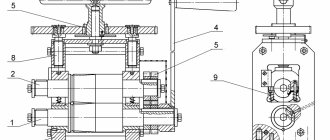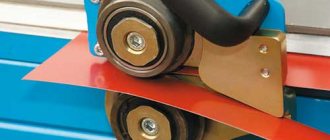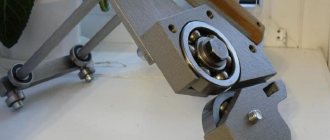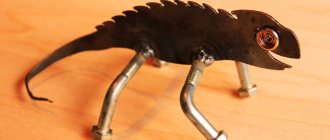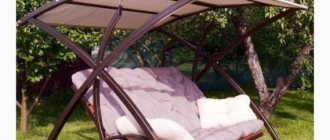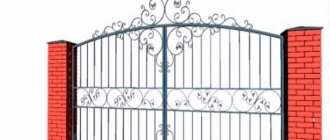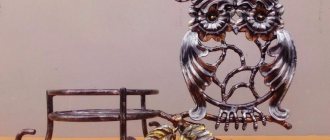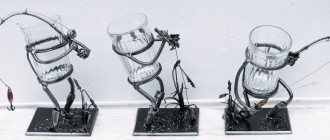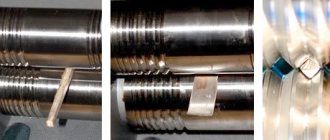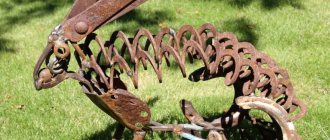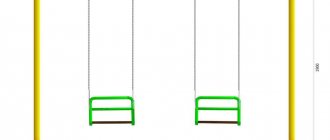Rolling of various types of metals is considered a popular technological operation that is performed at metalworking enterprises. The most popular areas where this technology is used are construction and repairs. You can make rollers for sheet metal yourself. However, to do this, you need to become familiar with the operating principle of this equipment, its design, strengths and weaknesses.
Rollers for sheet metal bending
Varieties
A rolling machine is present at various enterprises that produce various rolled metal products. Using this equipment, you can make oval, conical, and cylindrical workpieces.
At home, craftsmen make parts for roofing structures, air ducts, drains, gutters. Models are divided by performance, design, type of drive:
- Manual models. Compact machines with low weight, which are used for processing sheet metal, the walls of which do not exceed 2 mm in thickness. They do not require an electrical connection and are inexpensive. Often made by hand.
- Electromechanical models. A gearbox is installed on them, which speeds up the technological process and facilitates human labor. Allows processing of rolled metal up to 4 mm thick.
- Models with hydraulic drive. They are used at large metalworking enterprises. Allows you to bend metal sheets up to 8 mm thick.
To further speed up production and perform work more accurately, hydraulic machines are equipped with CNC systems. This type of control is difficult to create at home.
A separate division refers to the number of rollers installed on the machine. The more working parts installed, the more complex the molds can be made.
Types of rolling machines
The equipment used for rolling is simple and versatile , so you can make it yourself for home use. Production workshops are equipped with serial models of rollers, which are presented in a wide range on the market today.
All machines, depending on the number of rolls, are divided into four-, three- and two-roll. Three-rollers can be symmetrical or asymmetrical. Four-roll machines have an additional shaft, which simplifies the rolling process. All elements are securely interconnected, which minimizes the likelihood of sheet material slipping and increases processing speed.
According to the type of drive used, rollers are:
- hydraulic;
- manual;
- electric.
Manually driven rollers are very simple in design. Such a device does not require additional power to operate and has the following advantages:
- reliability;
- compactness and mobility;
- low cost;
- ease of maintenance and operation.
The disadvantages of this type of equipment include:
- impossibility of using metal products more than 2 mm thick when rolling;
- low productivity;
- bending a sheet blank will require significant physical effort.
Electrically driven machines are more efficient. They can be used to process sheet metal products of considerable thickness.
Hydraulically driven rollers are the most powerful. This type of device is characterized by large dimensions. As a rule, such equipment is installed at industrial enterprises.
Design and principle of operation
A roller machine consists of several key elements, after studying which its operating principle will become clear. These include:
- The supporting element, or as it is also called, the frame. Can be made of sheet steel or cast iron.
- Rollers, which can be from two to 4. During self-production, craftsmen recommend installing 3 rolls.
- Drive - electric or hydraulic (on manual models a handle is installed to control the rollers).
- Control Panel. Various sensors and a monitor are installed on CNC systems.
Working principle step by step:
- Initially, a sheet of metal is prepared that will be rolled. It should be smooth, without cracks or grooves. It is placed on two lower rollers. They are separated in different directions in advance.
- After this, the master lowers the third shaft towards the sheet in order to securely clamp it between the working parts.
- The lower rollers begin to rotate under the influence of a drive or human manual force. The sheet is moving. As it begins to move, it begins to bend around the rollers.
Gradually, the metal blank passes through all the working parts according to the given configurations until the product of the required shape is obtained.
CNC rollers in production
Specifics of rollers with a mechanical drive type
A manual rolling machine is a set of the following parts and mechanisms:
- metal frame with legs or stand;
- handle;
- rolls;
- eccentric clamp;
- emphasis;
- tilt and turn mechanism.
A galvanized, polymer-coated metal sheet is placed between the shafts and held with a clamp. Using the handle, the worker of the 3-roller bending roller drives the front shaft. The steel workpiece is rolled between two adjacent shafts. Thus, the metal sheet receives an even bend, turning into a shell.
When it is necessary to remove a finished cylindrical part from a roll bending machine, it is enough to open the lock and fold back the upper shaft. To make a new part, the worker repeats the process from the beginning.
Manufacturers
The following manufacturers are especially popular:
- Metalmaster - models from this company stand out for their reliability and durability. They make it possible to work with metal sheets, fittings, and pipes. Well-known models are MSR 1215 and MSR 1315.
- Stalex is another well-known company whose equipment is valued by customers. It is used when processing sheets of different thicknesses. The housings of this equipment are made of durable steel grades that have an increased corrosion resistance.
- Anchor Corvette. Not suitable for mass production due to low reliability, but for a small workshop they are a good option.
At the same time, buyers highlight companies such as JET, PRINZING, SAHINLER, SCHWARTMANNS. It is important to consider the technical characteristics and capabilities of the equipment.
Purpose of manual rollers for sheet metal
A machine with a mechanical drive type is produced for use in the following industries:
- construction and finishing works;
- aviation and mechanical engineering;
- equipment manufacturing;
- assembly of musical instruments;
- And etc.
A three-roll sheet bender with mechanics cannot compete with electromechanical equipment. It is well suited for small-scale production. However, if a manufacturer wants to opt for an economical purchase, then 3 roller rollers will be a profitable purchase. It is only worth considering the fact that the manufacturer cannot do without using the strength of the workforce.
Areas of application of machines
Rolling machines are installed at many metalworking enterprises. Among the areas in which they are used are:
- Jewelry production.
- Manufacturing of water drains and roofing elements.
- Utilities.
- Manufacturing of billboards and stands.
At the same time, different types of metals are used to produce different products. Machines for rolling sheet metal simplify construction and repair work.
Bending sheet metal on a machine
Characteristics of the rolling process
The fundamental feature of sheet metal rolling is that the deformation process occurs over the entire contact surface . This slightly reduces productivity, but increases the durability of the rolling work rolls. The advantages of metal rolling include:
- Reduced operating costs for tooling and equipment.
- Increasing the service life of tools and machines.
- Effective use in single and small-scale production.
- Reducing losses from marriage.
- Low cost of a rolling machine compared to a hydraulic or mechanical press. The cost of its acquisition pays off within six months of active use.
During the rolling process, the operator can change the rate of metal deformation. With other forming and stamping operations this is not always possible.
Rolling a sheet of metal can be done in several ways:
- in the transverse direction of the workpiece feed;
- in the longitudinal direction;
- with screw feed.
The first option is used to obtain short pipes, the second - long ones.
The sheet rolling process is characterized by the following features:
- Deformation is produced by torque, not force. The value of the torque depends on the conditions of contact friction, the diameter of the working rollers and the physical and mathematical characteristics of the material.
- When performing an operation, the rolling speed does not affect energy costs; on the contrary, as the indicator increases, the working force of the process decreases.
- The friction between the rollers depends directly on the surface. Reduced roughness leads to reduced friction. Therefore, during continuous operation of rolling machines, it is necessary to periodically grind the surface of the equipment.
When rolling a steel product up to 6 mm thick, the original metal is processed in a cold state. If you are working with parts made of thick sheet material, preheating is used. In such cases, the rolling machine is installed near furnaces with a non-oxidizing heating system. Due to this, the formation of surface scale is reduced.
If hot-rolled sheet metal is deformed, the sheet is straightened before rolling. This is stipulated by the technical requirements of GOST.
Application of devices
Bending operations for rolling sheet material are performed in production when it is not profitable to buy finished products or the number of orders is quite large. The main consumers of rolling equipment are the metallurgical, chemical industries, construction and many others.
Main directions of use of machines:
- Formation of cone-shaped and cylindrical products.
- Manufacturing of pipes and structures with radial bending.
- Drawing ellipses and other metal shapes.
The decision to purchase such bending rollers will greatly simplify the operations of bending these shapes and designs. And this will allow your enterprise to reach a new level of rolled metal production.
How to make an order
You can buy three-roll manual rollers by calling the office. You can purchase the required model by using the website service: adding the product to the cart.
Detailed information about the technical characteristics and price of three-roll plate bending rollers can be obtained from the managers of X-Profile. Delivery of goods is carried out by a transport company to the destination city. If you decide to buy three-roll rollers, we will help you calculate the favorable cost of transportation.
X-Profile cooperates both with cities of the Russian Federation and with neighboring republics: Belarus and Kazakhstan. Three-roll rollers will be an excellent purchase that will pay for itself in the near future.
DIY rollers for sheet metal (21 photos)
Homemade machine, rollers for sheet metal: photo and description of the manufacture of the machine.
Greetings! To work with sheet metal, you need a huge mountain of all kinds of different tools, and since there were ideas to make direct-flow resonators and mufflers, it was necessary to start with rollers.
Rollers, for those who don’t know, are designed for twisting sheet metal into a cone or cylinder.
In order not to try to come up with something on the go, and then redo everything ten times, the rollers were modeled in solid. This made life much easier) Firstly, it simplified the selection of bearings and the choice of the thickness of parts, everything can be calculated, look at state standards, dimensions, etc. Secondly, you don’t need to draw everything by hand on leaves and carry this rock painting to the turners.
All this was not modeled so quickly, because even with the dimensions and all the specifications, you need to constantly call everyone and everything to find out whether the part you need is on sale or whether they can make it for you just like that.
Then there is the wait for the production of all the necessary parts.
Parts for the machine.
Then there was another problem, this was the manufacture of shafts. But soon they arrived too.
The process of fitting and further assembly of the rollers begins.
The parts are cleaned, chamfered and welded.
Alas, the assembly control process was then interrupted. The rollers were assembled and began their work without a camera at hand. Almost a year later, I remembered that I had good material, and I had to take a little more photos to complete the set.
The design is a little shabby, but holds up well)
The weak point was the plate with the thread for the bolt. Well, how weak, at the time of design, no one told me that I will need to roll a 3mm sheet with a width of 350mm. Therefore, a periodic blow with milk, and the plate is smooth again)
A plate was also added to the side, because the guide was constantly trying to run to the side.
Rotation is carried out by a 20mm meter pipe with a lock at the end.
Some tests with hard materials with sharp corners left marks on the rollers.
And these are the shaft drive gears.
Both videos are connected to each other by a pair of sprockets from some kind of motorcycle and a chain. Oddly enough, the chain turned out to be reliable, and I still have no questions about it.
And here are the products themselves, made from 304 stainless steel sheet with a thickness of 1.5 and 1 mm
1.5 mm perforated pipe for a direct-flow resonator. Part length 400mm
Direct flow resonator housing. Sheet 1mm, length 400mm
Ready-made direct-flow resonator
The housings of the oval Z-shaped mufflers are also made on these rollers.
The quality of sheet bending is excellent, the only thing missing is an electric drive. But it is likely that someday he and the private owner will also appear.
The working field of the rollers is 410 mm, the minimum cylinder diameter is 60 mm. When working with 1mm sheets, it rotates easily and without straining. When working with 3mm plates, you need a smaller feed, otherwise it becomes difficult to rotate the shafts, because it is not attached to the table, the tool is not always needed in work, and it takes up space anywhere on the workbench, even for it.
Author: Yuri Shonets. Belarus.
Popular homemade products on our website
- DIY sheet metal bending machine
- DIY metal cauldron grill (27 photos)
- Do-it-yourself metal stove: photo and description of the design
- Do-it-yourself metal stove: effective…
- Do-it-yourself metal stove: diagram, dimensions, photos...
- Do-it-yourself sauna stove made of metal: photo,…
- DIY metal grill
- DIY metal stove
- DIY metal stove
- DIY metal fireplace stove
- Do-it-yourself sauna stove made of metal
- Homemade metal grill: dimensions, photos and description
- DIY walk-behind tractor (30 photos)
- Do-it-yourself UAZ dump truck (63 photos)
- DIY buggy from Oka (63 photos)
